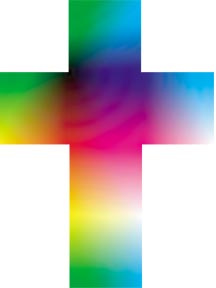 |
 |
|
From the white corner
|
From the black corner
|
|
The Physiological Color Cube
|
 |
| The human eye perceives black and white plus three colors. These three "primary" colors mix to form three "secondary" colors. Thus there are four axi of light perception: red to cyan, blue to yellow and green to magenta plus black to white. Since a cube has four corner-to-corner axi, the four axi of light perception can be meaningfully diagrammed in 3-D upon the surface of a cube.
The color cube graphically depicts the physiological function of the eyes. One axis through the cube is white-to-black. All shades of grey exist within the cube along this axis.The other axi are red-to-cyan, green-to-magenta and blue-to-yellow. Notice in the little figures at the top of the page that the outer corners of the cube represent the primary and secondary colors that the human eye can resolve. The corner in the center of each diagram is the axis of black to white. The "cross" figure can be folded into a cube. A high resolution one is available for printing in .pdf format in the secure section of this site. The human eye has rods and cones in the retina. The rods detect black, white and shades of grey. The rods are very slender and the cones are, in comparison, quite thick. There are many times more rods than cones. For this reason, the human eye is far more sensitive to shades of grey than to colors. One result is that when light is very dim, we barely see any colors. The cones detect colors. There are three types of cones. One type perceives red, another green and the third type blue. The cones can only resolve the three primary colors: red, green and blue. All our perception of other colors is a result of mixtures of these three basic psysiological colors. Yellow is perceived when red sensing and green sensing cones are equally stimulated. Magenta is an equal mixture of red and blue cone stimulation. Cyan is an equal mixture of blue and green cone stimulation. That means that even when your eye receives pure yellow spectral light, both the red and the green sensing cones are stimulated by it. The brain puts these two stimuli together, resulting in the perception of what we call yellow light. It is interesting to note that although they are colors of the spectrum, orange and violet are neither primary nor secondary colors of human perception. Orange exists between red and yellow. But for the eye, the perception of yellow results from an equal mixture of the signals from red and green cones. More red than green cone stimulation results in the perception of shades of orange. |
| The rainbow colors and the Tree of Life |